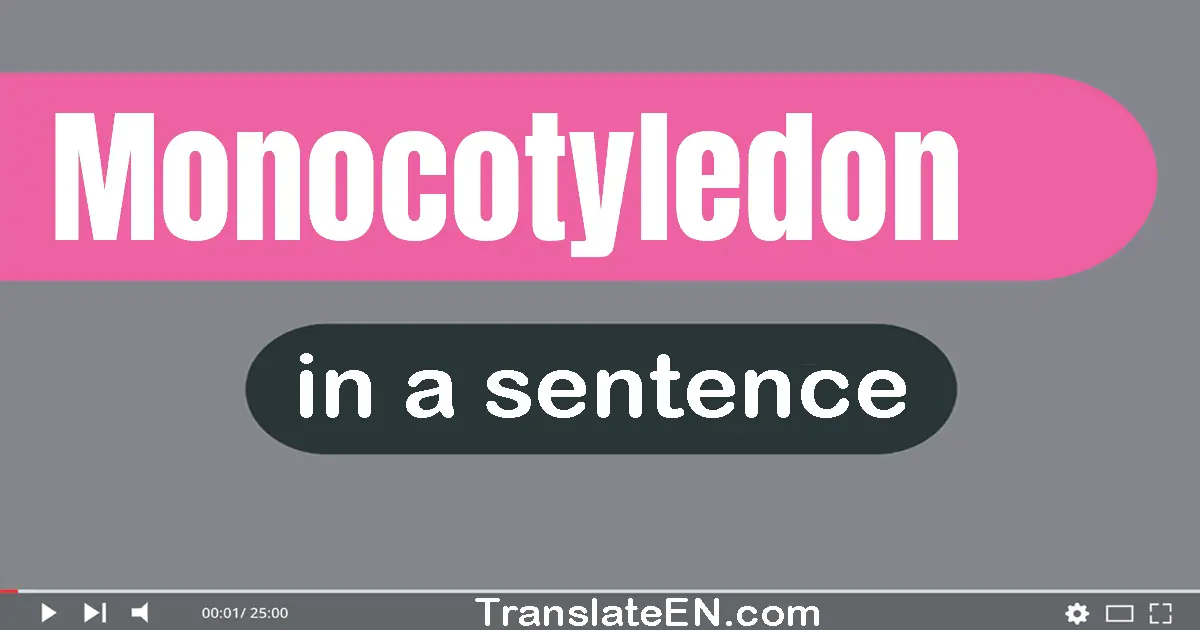Monocotyledon in a sentence
Synonym: monocot, flowering plant.
Meaning: Monocotyledon refers to a plant that has one seed leaf.

(1) The onion bulb is a monocotyledon plant.
(2) Monocotyledon plants have fibrous roots.
(3) The lily flower is a monocotyledon plant.
(4) Monocotyledon plants have a single seed leaf.
(5) Monocotyledon plants have only one seed leaf.
(6) Monocotyledon seeds are usually small and hard.
(7) The veins in monocotyledon leaves are parallel.
(8) The grass family is a type of monocotyledon plant.
(9) Monocotyledon plants include rice, wheat, and corn.
(10) The grass family is a group of monocotyledon plants.
Monocotyledon sentence
(11) The stem of a monocotyledon plant is usually hollow.
(12) The monocotyledon embryo contains only one cotyledon.
(13) Monocotyledon plants include lilies, orchids, and palms.
(14) Monocotyledon plants typically have fibrous root systems.
(15) Monocotyledon seeds are often dispersed by wind or water.
(16) Monocotyledon plants have parallel veins in their leaves.
(17) The bamboo plant is a tall and sturdy monocotyledon plant.
(18) Monocotyledon plants are commonly found in wetland habitats.
(19) Monocotyledon flowers often lack distinct sepals and petals.
(20) Monocotyledon seeds germinate by sending out a single shoot.
Monocotyledon make sentence
(21) Monocotyledon flowers are typically small and inconspicuous.
(22) Monocotyledon leaves have a sheath that wraps around the stem.
(23) Monocotyledon seeds are usually smaller than dicotyledon seeds.
(24) Dicotyledon seeds are typically larger than monocotyledon seeds.
(25) Monocotyledon plants are often used in landscaping and gardening.
(26) The orchid flower is a beautiful example of a monocotyledon plant.
(27) The dicotyledon group is more diverse than the monocotyledon group.
(28) Monocotyledon plants are often used for food, such as rice and corn.
(29) Monocotyledon seeds are usually small and have a protective seed coat.
(30) The flowers of monocotyledon plants are usually in multiples of three.
Sentence of monocotyledon
(31) Monocotyledon flowers may have reduced or absent reproductive structures.
(32) The monocotyledon group is one of the two main categories of flowering plants.
(33) Monocotyledon plants are often used in landscaping for their ornamental value.
(34) Monocotyledon flowers may have specialized structures to attract specific pollinators.
(35) The dicotyledon class is considered to be more primitive than the monocotyledon class.
(36) Monocotyledon plants are important for their role in oxygen production and carbon dioxide absorption.
(37) Monocotyledon seeds can remain dormant for extended periods until favorable conditions for germination occur.
(38) The classification of a plant as a dicotyledon or monocotyledon is based on the number of embryonic leaves present in the seed.
Monocotyledon meaning
Monocotyledon is a term used in botany to describe a type of flowering plant that has only one embryonic leaf, or cotyledon, in its seed. This is in contrast to dicotyledons, which have two embryonic leaves. Monocots are a diverse group of plants that include grasses, lilies, orchids, and palms, among others. If you are writing about monocotyledons, it is important to use the term correctly and in context. Here are some tips for using the word monocotyledon in a sentence:
1. Use it as a noun: Monocotyledon is a noun, so it should be used as such in a sentence.
For example, "The monocotyledon is a type of flowering plant that has only one embryonic leaf."
2. Use it in the singular form: Monocotyledon is a singular noun, so it should be used in the singular form in a sentence.
For example, "This monocotyledon has a long, slender stem and narrow leaves."
3. Use it in the plural form: If you are referring to multiple monocotyledons, use the plural form of the word.
For example, "The garden is filled with a variety of monocotyledons, including lilies, orchids, and grasses."
4. Use it in scientific writing: Monocotyledon is a technical term used in botany, so it is appropriate to use it in scientific writing.
For example, "The study found that monocotyledons have a unique pattern of vascular bundles in their leaves."
5. Use it in descriptive writing: If you are describing a plant or landscape, using the term monocotyledon can add specificity and detail.
For example, "The field was filled with a sea of green monocotyledons, swaying in the breeze."
6. Use it in educational writing: If you are writing about plants or botany for an educational audience, using the term monocotyledon can help teach readers about plant classification.
For example, "Monocotyledons are one of the two main groups of flowering plants, along with dicotyledons."
In conclusion, using the term monocotyledon correctly and in context can add precision and detail to your writing about plants and botany. Whether you are writing for a scientific audience or a general one, following these tips can help you use the word effectively in your sentences.
The word usage examples above have been gathered from various sources to reflect current and historical usage of the word Monocotyledon. They do not represent the opinions of TranslateEN.com.
